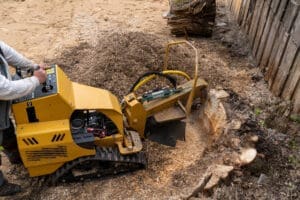You’ve just made the decision to cut down that old tree or those large, established shrubs in your yard. Now comes the question: should you leave the stump as is, or have it ground up? Stump removal is a crucial decision in home landscaping, with both benefits and drawbacks to consider. Here’s a brief overview of the pros and cons of stump removal, as well as the process involved in stump removal and grinding.
 The Pros of Stump Removal:
The Pros of Stump Removal:
1. Aesthetics
One of the most apparent benefits of stump removal is the improved aesthetics of your landscape. Stumps can be unsightly, disrupting the visual appeal of your yard. By removing them, you can create a more polished and attractive outdoor space.
2. Safety
Stumps pose safety hazards, especially in areas where people walk or play. They can be tripping hazards, particularly in low-light conditions. Removing stumps eliminates this risk, making your yard safer for your family and visitors.
3. Preventing Regrowth
Leaving a stump in the ground can lead to new shoots sprouting from the remaining root system. This regrowth can be challenging to manage and may require ongoing maintenance. Removing the stump entirely prevents this issue, saving you time and effort in the long run.
4. Space Utilization
Stump removal frees up space in your yard, allowing for new landscaping features or structures. Whether you want to install a garden bed, a patio, or expand your lawn, removing the stump provides more flexibility in designing your outdoor space.
The Cons of Stump Removal:
1. Cost
Stump removal can be expensive, especially if you hire professionals to do the job. The cost may vary depending on the size of the stump, accessibility, and the method used for removal. For budget-conscious homeowners, this expense could be a deterrent.
2. Labor Intensive
Stump removal is a labor-intensive process, requiring specialized equipment and expertise. If you choose to tackle the job yourself, be prepared for strenuous physical work and the potential risk of injury. Even with the right tools, removing a stubborn stump can be challenging and time-consuming.
3. Disruption to Landscape
The process of stump removal can disrupt your landscape temporarily. Heavy machinery may need to be brought in, which can damage surrounding plants or structures. Additionally, the removal process may leave behind a large hole that needs to be filled and leveled, further altering the landscape.
4. Environmental Impact
Stump removal can have environmental implications, particularly if chemicals or heavy machinery are used. Chemical stump removers may contain toxic ingredients that can harm soil quality and nearby plants. Additionally, the use of heavy machinery can compact soil and disturb the ecosystem below ground.
How it’s Done:
If you decide to go the route of stump removal, good planning and preparation will be critical. Here’s an overview of what you can expect. Most homeowners choose to hire a professional stump removal company to perform the work.
1. Assessment: Before beginning the removal process, assess the size and condition of the stump. Consider factors such as accessibility, proximity to structures, and the presence of underground utilities. If you’re hiring a professional, they should give you a bid for the work at this point.
2. Choose the Method: Decide whether you’ll remove the stump manually or use a stump grinder. Manual removal involves digging around the stump and cutting through the roots using an axe, shovel, or chainsaw. Stump grinding, on the other hand, utilizes a specialized machine to grind the stump into small wood chips.
3. Prepare the Area: Clear the area around the stump and remove any debris or obstacles that could hinder the removal process. Ensure that there are no underground utilities or pipes that could be damaged during the removal.
4. Execution: If opting for manual removal, start by digging around the stump to expose the roots. Cut through the roots using a chainsaw or an axe, gradually loosening the stump from the ground. Once the stump is loose, remove it from the hole and fill in the remaining space with soil.
If using a stump grinder, carefully operate the machine according to the manufacturer’s instructions. Position the grinder over the stump and gradually lower the cutting wheel into the wood, moving it back and forth until the stump is ground into small chips.
5. Cleanup: After removing the stump, clean up the area and dispose of any debris properly. Fill in the hole left by the stump with soil or mulch to level the ground and restore the landscape.
You’ll find everything you need for a beautiful yard and garden at Hilton Landscape Supply.
Stump removal in home landscaping comes with its own set of pros and cons. While it improves aesthetics, increases safety, and prevents regrowth, it can be costly, labor-intensive, and disruptive to the landscape. When deciding whether to remove a stump, weigh these factors carefully and consider the specific needs and constraints of your yard. If you choose to proceed with removal, follow the appropriate steps and safety precautions to ensure a successful outcome.
When you need good advice about creating a beautiful, healthy yard, Hilton Landscape Supply is the place to go. We’ve been serving Southern Oregon and Northern California since 1956, so we know what works best for growing healthy plants and vegetation in our regions. Stop by our retail store in Central Point or contact us for more information about all the products we carry to enhance your garden and outdoor living areas.

 The Pros of Stump Removal:
The Pros of Stump Removal: